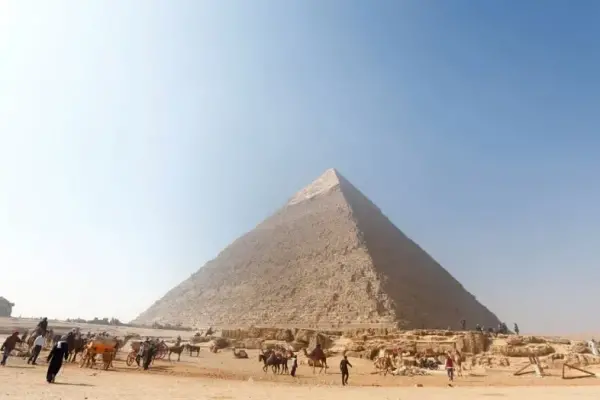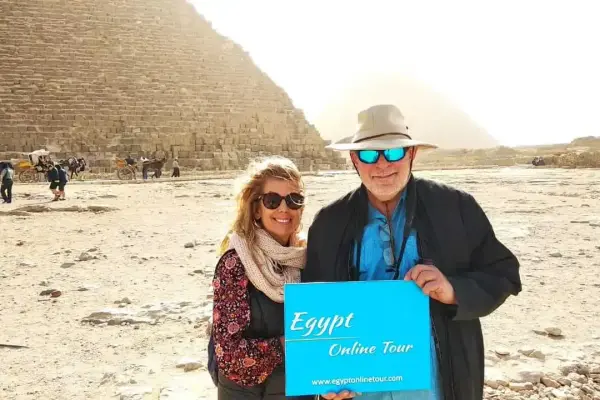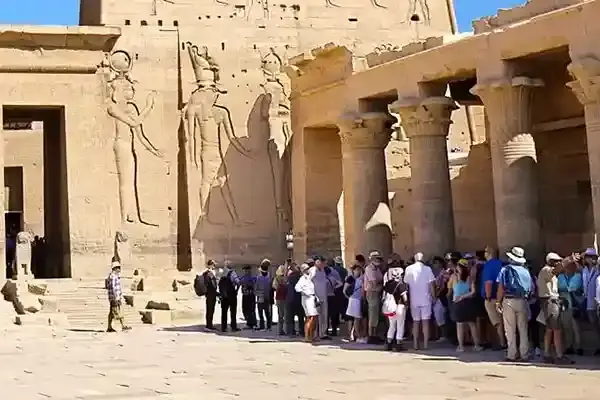15 Facts About Ancient Pyramids in Egypt You Didn’t Expect
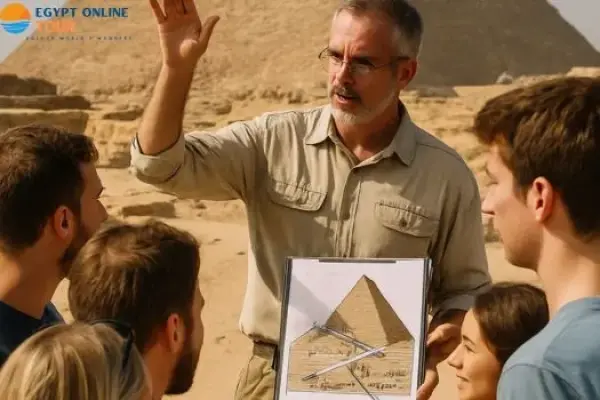
- May 22, 2025
- Ancient Egyptian Civilization
- 2,550
Facts about ancient pyramids in Egypt go far beyond Giza’s famous trio. Did you know Egypt holds over 130 pyramids, according to the Egyptian Ministry of Tourism (egypt.travel)? Some are hidden, some half-ruined—yet each tells a story. But how many still stand? And how big were they really? Let’s dig into 15 facts you probably never expected.
Table of contents [Show]
- 15 Surprising Truths About Egypt’s Pyramids: What Guidebooks Don’t Tell You
-
15 Fascinating Facts About Ancient Pyramids in Egypt: Secrets Unveiled
-
- 1. Precision That Puts Modern Builders to Shame
- 2. The Pyramid Workforce Had Benefits
- 3. The First Pyramid Was a Happy Accident
- 4. Secret Rooms & Modern-Day Treasure Hunts
- 5. Stars, Souls, and Sandstone
- 6. How They Built It Without Trucks or Cranes
- 7. The Original Tourist Trap (in 450 BCE)
- 8. Why They Looked Like Giant Diamonds
- 9. More Than Just Fancy Graves
- 10. Climate Change vs. Ancient Stone
- 11. The Giza Complex: A City of the Dead
- 12. Ancient Math Skills
- 13. A Lost River Helped
- 14. The Sphinx Connection
- 15. The Pyramids Today
- Key Pyramid Facts at a Glance
- Egypt’s Most Iconic Pyramids
- Why Visit with Egyp tOnline Tour?
-
-
How big were the pyramids? The Real Scale of Egypt’s Pyramids: 10 Jaw-Dropping Facts You’ve Never Heard
- 1. Stones That Could Circle the Earth Three Times
- 2. Taller Than the Eiffel Tower’s Frame
- 3. Bases Wider Than Major Airports
- 4. The combined weight is equivalent to thirty Empire State buildings.
- 5. Hidden Mini Pyramids Often Overlooked
- 6. Workers Moved Blocks Faster Than Your Weekend Walk
- 7. Melted Limestone Would Flood Manhattan
- 8. The Bent Pyramid’s Engineering Crisis
- 9. Humidity Threatens Their Survival Today
- 10. Modern Engineers Still Can’t Replicate Them
- Pyramid Size Cheat Sheet
- Why EgyptOnlineTour’s Guides Make the Pyramids Feel Real?
- How Many Pyramids Are There in Egypt? (Hint: It’s Not Just Giza)
- Where Are Egypt’s Pyramids?
- The Summary
15 Surprising Truths About Egypt’s Pyramids: What Guidebooks Don’t Tell You
The pyramids of Egypt aren’t just crumbling old tombs. They’re time machines made of stone, whispering stories about pharaohs, star-watching priests, and the everyday workers who pulled off the world’s most epic construction project.
Whether you are planning a trip or just curious, these facts about ancient pyramids in Egypt will open your eyes to their true marvel. For an unforgettable experience, check out this 10 Days Round Trip Nile Cruise and Pyramids tour .
15 Fascinating Facts About Ancient Pyramids in Egypt: Secrets Unveiled
Forget dry history lessons—here’s the real scoop on what makes these ancient wonders tick, plus tips to see them like a pro.
1. Precision That Puts Modern Builders to Shame
- The Great Pyramid’s sides line up with true north better than the Greenwich Observatory.
- How? Ancient Egyptians likely tracked stars like Kochab and Mizar 4,500 years ago.
- Workers fit 2.5-ton stones (as heavy as SUVs) with gaps thinner than a smartphone.
2. The Pyramid Workforce Had Benefits
- No whips, no chains. Skeletons found near Giza show laborers ate better than most Egyptians, regular beef and bread.
- Contrary to myth, evidence shows skilled workers, not slaves, built the pyramids; they were paid, honored, and lived in nearby villages
- They worked in shifts and even had access to medical care.
- Medical records on papyrus reveal they got paid sick leave for broken bones.
3. The First Pyramid Was a Happy Accident
- Pharaoh Djoser’s architect, Imhotep, kept adding layers to a simple tomb until it became the Step Pyramid—the world’s first skyscraper (203 feet tall).
- This oops-turned-genius design kickstarted Egypt’s pyramid craze.
4. Secret Rooms & Modern-Day Treasure Hunts
- In 2017, scientists found a hidden void in the Great Pyramid using cosmic ray technology. What’s inside? Tools? A pharaoh’s secret stash? We still don’t know.
- New tech like muography keeps revealing new secrets.
- Robbers stole most treasures, but in 1954, a 1,200-piece cedar boat was found buried near Khufu’s pyramid, still perfectly preserved.
5. Stars, Souls, and Sandstone
- The pyramids’ layout copies Orion’s Belt—Egyptians believed this constellation was the pharaoh’s afterlife highway.
- The Great Pyramid has narrow passageways that line up with important stars in the ancient sky.
- One points to Sirius, linked in ancient times to the soul’s passage. Another aligns with Alpha Draconis, the former pole star, believed to guide the pharaoh’s spirit to the afterlife.
6. How They Built It Without Trucks or Cranes
- Workers carved limestone with copper tools, softer than the stone itself, and wooden sleds and ramps were used.
- Wet sand likely helped reduce friction when dragging stones.
- In 2014, Dutch physicists proved that dragging stones on damp sand cuts effort by 50%. No WD-40 needed.
7. The Original Tourist Trap (in 450 BCE)
- Greek historian Herodotus griped about pushy souvenir sellers at Giza—proving some things never change.
- Today, sunrise tours let you dodge crowds and see the pyramids turn pink in the morning light.
8. Why They Looked Like Giant Diamonds
- The pyramids were originally covered in Tura limestone, polished so smooth they gleamed like mirrors.
- Earthquakes loosened most stones, but a few still cling to Khafre’s pyramid.
9. More Than Just Fancy Graves
- The Bent Pyramid’s wonky angle isn’t a mistake—it was a safety fix after engineers realized steep walls could collapse.
- The pyramids doubled as giant sundials, marking solstices with shadows. You can experience this history up close on t his 8-day Pyramids & Nile by Air tour
10. Climate Change vs. Ancient Stone
- Rising Nile humidity is dissolving pyramid cores 10x faster than natural erosion.
- UNESCO is now using AI to predict which hieroglyphs might vanish next.
11. The Giza Complex: A City of the Dead
- Each pyramid was part of a sprawling complex, including mortuary temples, worker villages, and smaller tombs for nobles.
- The Great Sphinx, guarding Khafre’s pyramid, adds to Giza’s mystique.
- This plateau wasn’t just a burial site—it was a hub of ritual and reverence.
12. Ancient Math Skills
- The pyramid’s base-to-height ratio reflects the number pi.
- This wasn’t random. It shows how well Egyptians understood math and measurements.
13. A Lost River Helped
- Recent studies suggest a now-lost branch of the Nile helped float blocks to the Giza Plateau. This discovery reshaped expert views on how the stones were moved to the pyramid sites.
14. The Sphinx Connection
- The Sphinx, next to Khafre’s pyramid, adds to Giza’s wonder.
- Its body may hide more chambers, but full digs haven’t been allowed.
15. The Pyramids Today
- Humidity, pollution, and crowds threaten the pyramids.
- Still, groups like UNESCO and Egypt’s experts continue to protect and preserve them.
Key Pyramid Facts at a Glance
Aspect | Detail | Significance |
Primary Purpose | Royal tombs for pharaohs and queens ensured eternal life. | Central to ancient Egyptian afterlife beliefs. |
Main Materials | Limestone, granite, and basalt. | Strong materials were brought from nearby quarries and distant locations. |
Workforce | Skilled craftsmen, farmers, and laborers, well-organized and paid. | Not slaves, a testament to societal structure. |
Astronomical Alignment | Often precisely aligned with cardinal directions. | Shows advanced astronomical knowledge and observation. |
Internal Design | Complex chambers, passages, and burial vaults. | Designed to protect royal burials and deter robbers. |
Famous Sites | Great Pyramid of Giza (Khufu), the Pyramid of Khafre, Step Pyramid of Djoser. | Iconic examples showcase different eras of construction. |
Architectural Evolution | From early step pyramids to smooth-sided, true pyramids. | Demonstrates continuous architectural advancements. |
Symbolism | Symbolized the pharaoh’s link to the gods, belief in rebirth, and journey to the afterlife. . | Deeply rooted in Egyptian religious and spiritual views. |
Modern Status | UNESCO World Heritage Sites, global tourist attractions. | Recognized for their immense cultural and historical value. |
Ongoing Research | New discoveries through modern technology, like muography. | Many mysteriesare still being explored and understood. |
Name | Location | Builder | Unique Feature |
Great Pyramid | Giza | Khufu | The last ancient wonder standing |
Step Pyramid | Saqqara | Djoser | The first pyramid ever built |
Bent Pyramid | Dahshur | Sneferu | Unusual angled sides |
Red Pyramid | Dahshur | Sneferu | First smooth-sided pyramid |
Pyramid of Khafre | Giza | Khafre | Sphinx connection |
Why Visit with Egyp tOnline Tour?
- Get expert guides who explain the hidden meanings in the designs.
- You access restricted areas like workers’ tombs and lesser-known paths.
- You help support preservation efforts with every booking.
Go early in the day. You’ll avoid the crowds and watch the sunlight hit the stones like it did thousands of years ago.
Book your tour now at Egypt Online Tour and explore the land where pharaohs once ruled.
Craft your pyramid story here with a visit to the Grand Egyptian Museum tour for a closer look at the treasures behind the stones.
Let our local travel experts help you design the perfect itinerary. Whether you're seeking adventure, culture, or relaxation, we've got you covered!
How big were the pyramids? The Real Scale of Egypt’s Pyramids: 10 Jaw-Dropping Facts You’ve Never Heard
The Egyptian pyramids, especially the Great Pyramid of Giza, are architectural marvels that continue to astonish with their immense scale and precision. Here’s a deep dive into their true magnitude and some astonishing facts beyond the usual statistics.
1. Stones That Could Circle the Earth Three Times
- Builders used around 2.3 million stone blocks, each weighing about 2.5 tons—roughly the weight of a rhino.
- Some massive stones near the base weighed over 80 tons. Moving these was an astonishing feat.
- If these stones were laid end to end, they would wrap around the Earth three times.
- Remarkably, this colossal feat was achieved without modern machinery, relying solely on human labor, ingenuity, and simple tools
2. Taller Than the Eiffel Tower’s Frame
- Before the Eiffel Tower overtook it in 1889, the Great Pyramid, which stood at 481 feet (146.6 meters) at its original height, was the highest man-made building on Earth for more than 3,800 years.
- To put it in perspective, its height is equivalent to stacking 40 giraffes or about the height of a modern 40-story building.
- Today, due to the removal of its smooth white limestone casing, it stands at about 454 feet (138.5 meters).
3. Bases Wider Than Major Airports
- The base of the Great Pyramid covers approximately 13 acres (about 230 meters per side)—larger than the footprint of LAX’s Terminal.
- The base is leveled with astonishing precision, within just two centimeters of flatness.
- Ancient builders achieved this by using water-filled trenches as leveling guides, a technique that highlights their advanced understanding of engineering.
4. The combined weight is equivalent to thirty Empire State buildings.
- The Great Pyramid’s colossal mass is believed to reach nearly 6 million tons—equivalent to stacking 30 Empire State Buildings or lining up 17 Burj Khalifas side by side.
- Modern construction to match this would require about 7,000 dump trucks hauling loads continuously for 30 years..
5. Hidden Mini Pyramids Often Overlooked
- Behind the massive pyramids at Giza lie smaller Queen’s Pyramids, about the height of a six-story building.
- These lesser-known pyramids are adorned with intricate carvings and offer a quieter, less crowded experience for visitors seeking to explore beyond the main attractions.
6. Workers Moved Blocks Faster Than Your Weekend Walk
- Teams of laborers dragged the 2.5-ton blocks about 500 feet per hour over wet sand.
- This method was efficient because damp sand reduces friction by half, making it easier to slide heavy stones.
- This ancient physics hack allowed the workforce to maintain a steady pace without modern machinery.
7. Melted Limestone Would Flood Manhattan
- The volume of the Great Pyramid is approximately 92 million cubic feet (2.6 million cubic meters).
- If the limestone were melted into a liquid form, it could cover New York City in two feet of stone soup or fill 63,000 Olympic-sized swimming pools—a staggering visualization of its mass.
8. The Bent Pyramid’s Engineering Crisis
- The Bent Pyramid, another pyramid at Dahshur built by Pharaoh Snefru, was originally planned to be taller, but its top is 43 feet shorter than intended.
- Builders altered the angle mid-construction, fearing structural collapse—a rare ancient example of adaptive engineering and risk management.
9. Humidity Threatens Their Survival Today
- While the pyramids have withstood millennia of desert winds, rising humidity and moisture are now their greatest threat, accelerating the decay of the inner limestone at a rate ten times faster than wind erosion.
- UNESCO employs modern technology like drones to scan for cracks daily, acting as pyramid doctors to monitor and protect these ancient structures.
10. Modern Engineers Still Can’t Replicate Them
- Back in 1978, a team of Japanese engineers tried to recreate sections of the Great Pyramids using modern cranes and laser technology—but even with advanced tools, they couldn’t match the ancient builders’ astonishing precision and scale.
- This highlights how the brilliance and craftsmanship of ancient Egyptian builders continue to outshine even the most advanced modern technologies
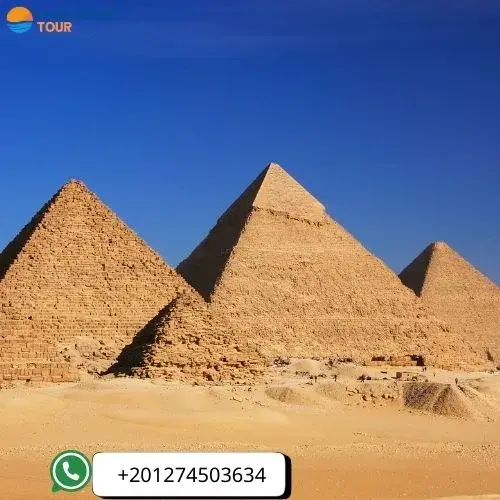
Pyramid Size Cheat Sheet
Pyramid Name | Original Height | Base Area | Weight | Wild Fact |
Great Pyramid | 481 ft (146.6 m) | 13 acres | 6 million tons | Stones could circle Earth 3 times |
Bent Pyramid | 344 ft (105 m) | 6.3 acres | 3 million tons | The angle shift saved it from collapse |
Red Pyramid | 341 ft (104 m) | 7.8 acres | 4 million tons | First successful smooth-sided pyramid |
Step Pyramid | 203 ft (62 m) | 4.7 acres | 850,000 tons | World’s first large-scale stone “skyscraper” |
Khafre’s Pyramid | 471 ft (143.5 m) | 11 acres | 5 million tons | Retains some of its original casing stones |
Why EgyptOnlineTour’s Guides Make the Pyramids Feel Real?
- No-boring-numbers rule: Guides use 3D-printed mini pyramids to demonstrate exact scale.
- Sunrise secret: Witness shadows stretching over 1.2 miles at dawn with zero crowds.
- Workers’ stories: Learn how ancient builders relaxed with beer after moving stones weighing up to 80 tons.
Join the Stone Movers tour to measure blocks using ancient rope techniques—fun and educational for all ages.
Finally, the pyramids are not just monumental in size, they are a defiant testament to human ingenuity, endurance, and belief in eternity. To truly grasp their scale, stand at the base at sunset and feel the awe that has captivated humanity for millennia. While you're planning your trip, don’t miss exploring the best cities to visit in Egypt 2025 to complete the experience.
How Many Pyramids Are There in Egypt? (Hint: It’s Not Just Giza)
Most people picture Egypt’s three Giza giants when they think of pyramids. But that’s just the start. Facts about ancient pyramids in Egypt reveal a much wider story. Egypt’s deserts are full of hidden tombs, forgotten queens, and mysterious ruins—and even experts can’t agree on the real count. What are 3 major achievements of ancient Egypt? So, how many pyramids are there in Egypt? Let’s dig into the facts, the debates, and where you can find these ancient wonders.
The Short Answer
Egypt has between 118 and 138 known pyramids. The number isn’t set in stone—literally. Discoveries, collapsed ruins, and endless debates over “is it a pyramid or just a hill?” keep archaeologists busy.
Why the Numbers Change?
- New finds: Archaeologists keep unearthing buried ruins, sometimes right under a farmer’s field.
- Ruins and erosion: Sandstorms and time have buried or erased many pyramids.
- Debates: Some count only royal tombs. Others include smaller, half-finished, or ruined structures.
- Tech upgrades: Lidar and satellite scans reveal hidden sites every few years.
- Disagreements: Some pyramids are just mounds or platforms—experts argue over what counts.
What Counts as a Pyramid?
Not every pyramid is a giant stone marvel. Some are tiny, A handful are hardly more than a mound of boulders, while others are in ruins. Here’s what makes the count tricky:
- Unfinished or collapsed pyramids are hard to spot.
- Satellite pyramids for queens or nobles are smaller and often missed.
- Experimental pyramids show ancient trial and error.
- Lost pyramids may only be known from old maps or texts.

Egypt’s Pyramid Count Cheat Sheet
Category | Number | Example | Why It Matters |
Royal Pyramids | ~50 | Giza, Saqqara | Pharaohs’ tombs, mostly emptied by robbers |
Queen Pyramids | ~20 | Giza’s “mini” pyramids | Built for wives/mothers, tell family stories |
Experimental Fails | ~10 | Bent Pyramid | Reveal how builders learned and adapted |
Lost/Contested | ~60 | Sinki, Layer Pyramid | Archaeologists still debate their true nature |
Where Are Egypt’s Pyramids?
Region/Site | Estimated Pyramids | Key Examples | Notes |
Giza | 9 | Great Pyramid, Khafre, Menkaure, 6 Queens | Most famous, most photographed |
Saqqara | 16+ | Step Pyramid (Djoser), Unas, Teti | Oldest, many styles |
Dahshur | 7 | Bent Pyramid, Red Pyramid | Sneferu’s experiments, less crowded |
Abusir | 14 | Sahure, Neferirkare | 5th dynasty royal tombs |
Abu Rawash | 1 | Djedefre | Northernmost pyramid |
Zawyet El Aryan | 2 | Unfinished pyramids | Rarely visited |
Hawara, Lahun, Lisht | Several | Amenemhat III, Senusret II | Middle Kingdom, mudbrick structures |
The Classics: Giza’s Big 3 (Plus 6 You Missed)
- Khufu’s Great Pyramid: Still standing after 4,500 years
- Pyramid of Khafre: Looks taller, but it’s on higher ground.
- Pyramid of Menkaure: Smallest of the three, finished with red granite.
- Queen’s Pyramids: Six smaller pyramids at Giza, built for wives and mothers. Most tourists walk right past them.
Fun fact: Giza’s trio gets almost all the attention, but those smaller pyramids nearby are packed with stories.
The Originals: Step and Early Pyramids
- Step Pyramid of Djoser: Egypt’s first pyramid, built around 2650 BCE at Saqqara. It began as a simple flat tomb until Imhotep transformed it by adding six stone tiers on top.
- The Meidum Pyramid was one of the earliest efforts—it partially collapsed but revealed how ancient builders refined their designs through mistakes.
- Layer Pyramid, Sinki Pyramid: Lesser-known, often debated if they’re true pyramids or just failed experiments.
The Oops Pyramids: Bent and Red
- Bent Pyramid: Builders changed the angle halfway up to avoid collapse. It’s unique, and you can walk inside.
- Red Pyramid: First successful smooth-sided pyramid, also built by Sneferu at Dahshur. Cooler inside than Giza’s sweatbox.
The Lost and Maybe Pyramids
- Pyramid of Djedefre: Only the base remains—Romans took most of the stone.
- Lepsius Pyramid 1: Mapped in 1842. Now? A sand dune with an identity crisis.
- Sinki Pyramid: Some say pyramid, others say “weird rock platform.” The debate goes on.
Why Egypt’s Pyramids Matter
These monuments aren’t just stone piles. They’re time capsules of faith, ambition, and ancient engineering. Each one tells a story of ego, family, and sometimes, epic mistakes. From the first rough steps to the smooth giants, every pyramid adds a chapter to Egypt’s story. Wondering how to turn this into a trip? Start with this: How to Plan a Family Vacation in Egypt from USA ?
Where to See Pyramids (Without the Crowds)
- Saqqara: Home to 16+ pyramids. Don’t just see Djoser’s—Unas’ pyramid has walls covered in ancient spells.
- Dahshur: Bent and Red Pyramids, Dahshur is quiet and lets you climb inside real pyramids.
- Abusir: 14 pyramids, feels like another planet, but with fewer tourists.
- Hawara and Lahun: Mudbrick pyramids, often missed by tour groups.
Pro Tips for Pyramid Fans
- Go early for cooler weather and better photos.
- Don’t skip the smaller pyramids—many have hidden carvings and stories.
- EgyptOnlineTour offers routes to lesser-known sites and guides who make history real.
- Travel tip: Visit from November to February—the best months to visit Egypt —for cool weather and quiet sites.
Quick Facts About Ancient Pyramids in Egypt
- Most pyramids were royal tombs
- Sneferu built more than any other pharaoh
- The oldest is Djoser’s Step Pyramid at Saqqara.
- Khufu’s pyramid is the biggest and most well-known among all the pyramids in Egypt.
- Most sit near the Nile and the ancient capital, Memphis
- Some were made of mudbrick, so they decayed faster than stone.
- New pyramids are still being discovered—even today.
Facts about ancient pyramids in Egypt show that the pyramid count is always shifting. Whether you count 118 or 138, each one is a window into the past. They’re not just tourist sites—they’re proof of a civilization’s drive, belief, and creativity. If you want more than just Giza, explore the quieter sites, check the Grand Egyptian Museum ticket price , and discover the real story.
Ready to see Egypt’s pyramids beyond the usual tour? Take a look at this 10-day Nile cruise and pyramids trip for a full experience that combines history and scenery.
Let our local travel experts help you design the perfect itinerary. Whether you're seeking adventure, culture, or relaxation, we've got you covered!
The Summary
These facts about ancient pyramids in Egypt show there’s so much more than Giza. From hidden tombs to surprising sizes, the real story is deeper than most think. So, why stop at just reading? EgyptOnlineTour can help you explore these places for real—with guides who know where the crowds don’t go. Ready to see the forgotten side of Egypt’s history? Book your tour and start the journey where the usual tours end.
Popular Categories
Popular Posts

Top Alexandria Beaches You Must Visit 2026

What are the important holidays in Egypt?
